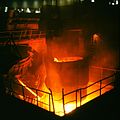Steel mills in the U.S. fall into two categories: traditional integrated mills that process iron ore into steel and mini-mills that melt steel scrap to produce new steel. Mini-mills now dominate U.S. steel production.
Integrated steel mills
In 2017, there were 9 operating integrated steel mills in the United States (plus one idled), down from 13 in 2000. Integrated mills produced 31% of the steel produced in the US.
In an integrated steel mill, iron ore is reduced to metallic iron. In the US, this is done in blast furnaces and since 2014 again using direct reduced iron furnaces in Nucor's plant in Louisiana as well as another DRI plant (producing a compactified version of DRI called hot briquetted iron, or HBI) in Texas by Voestalpine. Some of the iron from the blast furnaces is converted to steel; today this is done in basic oxygen furnaces. Iron ore, coke, and flux are fed into the blast furnace and heated. The coke reduces the iron oxide in the ore to metallic iron, and the molten mass separates into slag and iron. Some of the iron from the blast furnace is cooled, and marketed as pig iron; the rest flows into basic oxygen furnaces, where it is converted into steel. Iron and steel scrap may be added to both the blast furnace and the basic iron furnace.
US Steel operates a number of integrated steel mills, including the Gary Works in Gary, Indiana. They also operate the Edgar Thomson Works, which is the iron- and steel-making unit of the Mon Valley Works, which includes three other related plants. The company operates the Great Lakes Works, [6] and Granite City Works. [7]
Cleveland-Cliffs operates every integrated steel mill: in East Chicago, Indiana, Burns Harbor, Indiana, and Cleveland, Ohio. [8]
The Ashland Works was demolished.
Current integrated steel mills in the US
| Name | Location | Owner | Status and Date |
|---|
| Gary Works | Gary, Indiana | US Steel | Operating, February 2015 [9] |
| Mon Valley Works - Irvin Plant, Edgar Thomson Steel Works | North Braddock, Pennsylvania | US Steel | |
| Indiana Harbor Works | East Chicago, Indiana | Cleveland-Cliffs | |
| Burns Harbor Works | Burns Harbor, Indiana | Cleveland-Cliffs | |
| Middletown Works | Middletown, Ohio | Cleveland-Cliffs | |
| Cleveland Works | Cleveland, Ohio | Cleveland-Cliffs | |
| Dearborn Works | Dearborn, Michigan | Cleveland-Cliffs | One operating blast furnace ("A") Formerly Severstal Dearborn (2004–2014) Previously Rouge Steel (1989–2004) Previously Ford Rouge Plant (1910–1989) |
| Great Lakes Works | River Rouge and Ecorse, Michigan | US Steel | Blast furnace and iron production idled December 2019. [6] Automotive finishing lines remain open as of 2024. [10] |
| Granite City Works | Granite City, Illinois | US Steel | Resumed operation 2018 [11] Idled indefinitely in 2023. [12] |
| Fairfield Works | Fairfield, Alabama | US Steel | Blast furnace closed permanently in August 2015. [13] Electric arc furnace opened in 2020 and is currently operating as of 2024. [14] |
|


